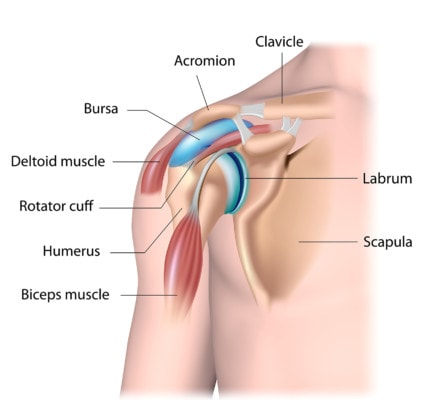Acromioplasty: Why This Frequent Addition to Rotator Cuff Surgery Is Usually a Bad Idea

Alila Medical Media/Shutterstock
Acromioplasty: To Chop a Shoulder or Not Chop a Shoulder…That Is the Question
Is acromioplasty a beneficial addition to rotator cuff surgery, and is recovery time impacted by this addition to shoulder surgery? One of the big issues with rotator cuff surgery is the long recovery time spent in an immobilizer brace. Unfortunately, the more procedures a surgeon performs during the surgery (including the addition of acromioplasty), the longer the recovery time.
What Is Acromioplasty?
Unlike many of the surgeries that I think about on a regular basis, acromioplasty is a shoulder surgery that on the surface makes a lot of sense and has always seemed well-intentioned to me. However, like a large number of surgeries that look reasonable on paper, acromioplasty has a number of unintended consequences.
Acromioplasty surgery is performed based on the concept that the shoulder rotator cuff is being pressed upon (impinged) by the bones and ligaments above the rotator cuff. The surgeon will cut these ligaments and shave down a piece of the acromion, which is a bone that sticks out of the front part of the shoulder blade. The major concern is that these ligaments are also some of the major stabilizers of the shoulder, so when you cut them, you end up with an unstable and sloppy shoulder, which is a slippery slope to shoulder arthritis and other rotator cuff injuries.
For more on the long-term implications of instability in ANY joint, download the Regenexx e-book, Orthopedics 2.0. It’s free and it’s a best seller on Amazon.
The Implications of Acromioplasty as an Add-On to Rotator Cuff Surgery
Is it really necessary to cut these ligaments, especially considering that this additional procedure may add to a patient’s rotator cuff surgery recovery time? A high-level study set out to answer that question. The study randomized patients into one group where a rotator cuff tear was repaired and another where the surgeon added an acromioplasty. The result was that there was no outcome advantage to shaving down the bone and cutting these important ligaments. And as you can imagine, all of the additional work and trauma that goes into a procedure like acromioplasty also results in a longer and more difficult recovery period for the patient.
The upshot? If you’re planning on getting your rotator cuff tear repaired through surgery, talk to your surgeon before he or she cuts out these important structures. But even before that, consider rotator cuff stem cell injections or platelet rich plasma before shoulder surgery, as this dramatically reduces recovery time and is an excellent alternative for a large number of patients who fall into the “rotator cuff tear” category.
In the uncommon circumstance where there is severe impingement by an extra-large acromion bone or very large bone spurs, acromioplasty may be a good option to help resolve the problem.
To find out if you might be a candidate for a Regenexx stem cell procedure, complete our Regenexx Procedure Candidate Form online.
If you have questions or comments about this blog post, please email us at [email protected]
NOTE: This blog post provides general information to help the reader better understand regenerative medicine, musculoskeletal health, and related subjects. All content provided in this blog, website, or any linked materials, including text, graphics, images, patient profiles, outcomes, and information, are not intended and should not be considered or used as a substitute for medical advice, diagnosis, or treatment. Please always consult with a professional and certified healthcare provider to discuss if a treatment is right for you.